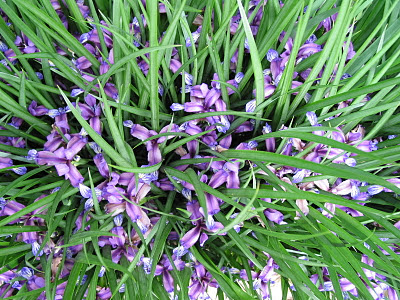I have traveled all over the U. S. doing seminars and judge's training sessions. Many of these were on spuria irises. I have been hybridizing tall bearded irises for over 30 years and spurias for 15 or more. When I look at where tall bearded irises have progressed to in 30 years, I all I can say is "WOW." When I look at spurias, I see improvements, but the WOW factor just isn't there.
 |
| Neurotic (Hedgecock 2011) Is this a new color break in Spuria irises? |
As hybridizers of spurias, we need to develop some goals in our programs. It is absolutely okay to just make crosses and see what happens, but what are you hoping to get from that cross? I hope many of you will answer better form, better substance, and certainly new colors and patterns.
I often ask spuria people that know more than a little about these irises, "Do you think there are patterns that can be exploited in spuria irises?" My most common reply is, " I don't know of any."
I know of one hybridizer that wants to produce a line of spurias without signals. I see this as a very doable goal, especially since I have several dark seedlings that have virtually no signals. Another wants to work in the miniature spuria field.
The important thing is to pick an area you think you like and get started. Look for spurias that have some of the traits you are looking for in your finished product and start hybridizing.
Are there patterns in spuria irises? Undoubtedly there are, but they haven't been established at this time.
One area that I find most interesting is the signals on the falls. One question that always come up is, "Are there color bands on the falls or do the signal patches simply expand to nearly the fall edges?" My opinion is that there are definite bands of color that are separate from the expanded signals colors. This is quite apparent in some varieties. This is a possible pattern that could show much promise in future breeding efforts.
When I started crossing spurias, I noticed that there were some varieties that had dark solid standards and falls with a large signal patch and edges of the same color as the standards. I borrowed a term from tall bearded irises and started calling these dark tops. I made some crosses with these as a possible pattern and the results were, at least some of the seedlings came in this pattern in varying colors. I believe this is a pattern that can be exploited.
We only have approximately 750 spuria cultivars to work with and a number of these are no longer in commerce. Using promising seedlings in your program is so very important. If you think you see something that makes your seedling different, by all means use it in your crosses.
I want to hear from anyone about your spuria seedlings and what you are doing in your hybridizing efforts. Together, we can make one of the world's greatest irises a house hold name.
God Bless you and your gardens.
Respectfully,
Jim Hedgecock
President Spuria Society
















































